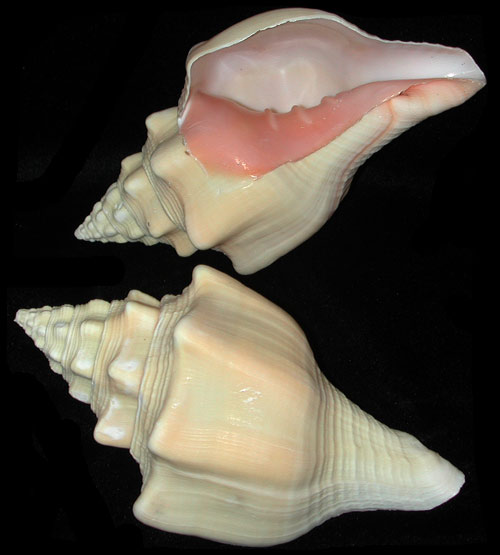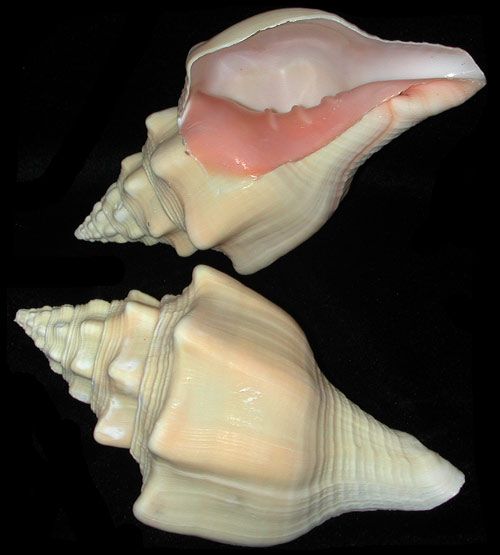One West Indian Chank shell measuring between 5 and 6 inches ******
One West Indian Chank shell, measuring between 5 and 6 inches
Orders usually process within 2 to 5 business days.
Email us at ja1@mindspring.com Make Your Selections and Shipping Preference. We Will Email You the amount of the Shipping Cost. When you receive the shipping cost go back into Shells of Aquarius and click into Purchase Shipping Label. There you will find UPS or USPS. Click into the option you decided on and make your payment. Your order will ship when shipping payment is received.
Turbinella Angulata
Turbinella angulata, common name the West Indian chank shell or Lamp Shell, is a species of a very large tropical sea snail with a gill and an operculum, a marine gastropod mollusk in the family Turbinellidae. The name "chank" for the shell of this species is derived from the word shankha, the divine conch or sacred conch,
A gill is a respiratory organ that many aquatic organisms use to extract dissolved oxygen from water and to excrete carbon dioxide.
The operculum is attached to the upper surface of the foot and in its most complete state, it serves as a sort of "trapdoor" to close the aperture of the shell when the soft parts of the animal are retracted. The shape of the operculum varies greatly from one family of gastropods to another. It is fairly often circular, or more or less oval in shape. In species where the operculum fits snugly, its outline corresponds exactly to the shape of the aperture of the shell and it serves to seal the entrance of the shell.
The gastropods commonly known as slugs and snails, belong to a large taxonomic class of invertebrates within the phylum Mollusca called Gastropoda.
This species is found in the Western Atlantic Ocean from the Florida Keys and the Bahamas south to Cuba, the Dominican Republic, Jamaica and Haiti, and on the Caribbean coast of Mexico, Belize, Honduras, Nicaragua, Costa Rica, Panama and Colombia.
West Indian Chanks are large reef-associated gastropods that can be found in tropical environment on subtidal and offshore mud, on rock or sand beds, and on mangrove lagoons, at depths of under 3 feet to depths of 148 feet.
The West Indian Chank are carnivorous animals feeding on worms and clams
The shells of Turbinella angulata can reach a size of 5 to 20 inches. These large shells are heavy and fusiform, with a sculpture of 8 to 10 prominent ribs angled at the shoulder. Columella shows three strong folds. The basic color of the external shell surface is white, while the inner may be pink or orange.
fusiform means tapering at both ends; spindle-shaped.
Turbinella/Chank Shells
Turbinella is a genus of very large sea snails with an operculum, marine gastropod mollusks in the subfamily Turbinellinae of the family Turbinellidae. These species are sometimes known as "chanks" or "chank shells".
The operculum is attached to the upper surface of the foot and in its most complete state, it serves as a sort of "trapdoor" to close the aperture of the shell when the soft parts of the animal are retracted. The shape of the operculum varies greatly from one family of gastropods to another. It is fairly often circular, or more or less oval in shape. In species where the operculum fits snugly, its outline corresponds exactly to the shape of the aperture of the shell and it serves to seal the entrance of the shell.
The aperture is an opening in certain kinds of mollusk shells: it is the main opening of the shell, where the head-foot part of the body of the animal emerges for locomotion, feeding, etc.
Species in this genus are found worldwide, mostly in tropical shallow waters but some have been found in depths to 6000 feet.
The shell is smooth, thick and obconic. The body whorl is large. The spire is obtuse. The apex is papillary. The aperture is oblong and narrow. The siphonal canal is long and straight. The columella grows several strong transverse plaits in the middle. The outer lip is thin and simple.
They are a small family of shells, totaling about 25 species. Chanks can range from 1/2 inch to 14 inches in size.
obconic means shaped like a cone and attached at the pointed end
the body whorl, or last whorl, is the most recently formed and largest whorl (or revolution) of a spiral or helical shell, terminating in the aperture. It is called the "body whorl" because most of the body of the soft parts of the animal fits into this whorl.
The spire is a tapering, pointed part of something; a tall, sharp-pointed summit or peak.
obtuse is of an angle more than 90° and less than 180°.
papillary is a small nipplelike projection.siphonal canal is a tubular or troughlike extension of the aperture for the enclosure of the siphon.
A siphon is a tube used to convey liquid upwards from a reservoir and then down to a lower level of its own accord. Once the liquid has been forced into the tube, typically by suction or immersion, flow continues unaided.
Scientific classification
Domain: Eukaryota
Kingdom: Animalia
Phylum: Mollusca
Class: Gastropoda
Subclass: Caenogastropoda
Order: Neogastropoda
Superfamily: Turbinelloidea
Family: Turbinellidae
Subfamily: Turbinellinae
Genus: Turbinella
Lamarck, 1799
(REF: Trueman, A.E. (1940). The ammonite body-chamber, with special reference to the buoyancy and mode of life of the living ammonite. Quarterly Journal of the Geological Society 96) (REF: Pilsbry H. A. & Cooke C. M. 1918-1920. Manual of Conchology. Second series: Pulmonata. Volume 25. Pupillidae (Gastrocoptinae, Vertigininae). Philadelphia.) (REF: Bouchet, P. (2011). Turbinella Lamarck, 1799. Accessed through: World Register of Marine Species) (REF: Adams, H. & Adams, A. (1853-1858). The genera of Recent Mollusca; arranged according to their organization. London, van Voorst.)

